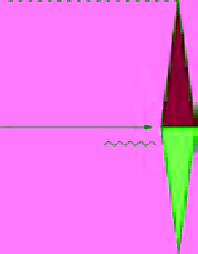Geoscience Reference
In-Depth Information
been found in the Statfjord case study that justifies
the systematic use of steady state A/S and there-
fore only positive and increasing or decreasing
(non-steady state) A/S responses were applied in
addition to degradation periods.
Consequently, two cases of fluvial A/S trends
are defined associated with three key fluvial
stratigraphic levels of which one can be identi-
fied as a surface (comparable to concepts applied
by Allen
et al
., 1996 and Diessel
et al
., 1999;
methods for their identification are outlined in
subsequent sections):
(A)
Maximum aggradation level
Increasing aggradation
Minimum aggradation level
or subaerial unconformity
Decreasing aggradation
(B)
1
Describing the situation in which degradation
does not occur and no subaerial unconformity is
formed. For 0 < A/S ≤ 1, an increasing A/S trend
and a decreasing A/S trend is recognised
(Fig. 4A; see also Sweet
et al
., 2005). Either the
turn-around from increasing to decreasing A/S
(relative maximum aggradation surface) or the
turn-around from decreasing to increasing A/S
(relative minimum aggradation surface) can be
chosen as the correlation level.
2
Describing the situation in which both aggrada-
tion (A/S > 0) and degradation occur (A/S < 0)
within an A/S cycle. In this case, the subaerial
unconformity (formed during the time span from
the turn-around from aggradation to degradation
to aggradation associated with no deposition
during a time period at the studied locality)
serves as the correlation surface.
or
Fig. 4.
Accommodation to sediment supply (A/S) relation-
ships. (A) The direction of change of the accommodation to
sediment supply (A/S) value can result in either an increas-
ing value (blue triangle) or a decreasing value (red triangle).
Together, they form an A/S cycle. The relative maximum
aggradation surface is picked at the turn-around from
increasing to decreasing A/S. The relative minimum aggra-
dation surface is picked at the turn-around from decreasing
to increasing A/S. If the value of A/S is not equal to zero or
does not fall below zero a subaerial unconformity is not
formed. (B) Considering a fluvial stratigraphic succession
in three dimensions, a relative minimum aggradation sur-
face related to a specific time scale in one position may rep-
resent a full A/S cycle developed at a shorter time scale in
another location.
Case 1 can occur as a higher frequency sequence
formed within the time represented by the hiatus
in case 2. A relative minimum aggradation corre-
lation level or a subaerial unconformity can
become eroded by a successive subaerial uncon-
formity if the decreasing A/S trend is of such mag-
nitude that the foregoing sequence is completely
eroded away (Fig. 4B).
The relative minimum and maximum aggrada-
tion levels may be difficult or impossible to recog-
nise as a single surface in high-accommodation
settings associated with a rapid sedimentation rate
(
cf
. Rygel & Gibling, 2006) or due to the way the
turn-arounds are expressed, the scale of resolution
(vertically and/or laterally) as well as autogenic
shadowing (
cf
. Kjemperud, 2008). More commonly,
a zone can be recognised in which the turn-around
occurs. For example, decreasing palaeosol matura-
tion values stratigraphically upward from a mature
caliche horizon suggest increasing A/S values
whereas increasing palaeosol maturation values
suggest decreasing A/S values (Fig. 5). The subae-
rial unconformity may form at the base of extensive
sandstone/conglomeratic units with or without
combination with fine-grained clastics or entirely
within fine-grained clastics (Sweet
et al
., 2005).
The definition of the low accommodation and
high accommodation systems tracts of Dahle
et al
.
(1997) and Martinsen
et al
. (1999), defined based
on changing fluvial accommodation conditions
through time (see also the discussion in Catuneanu,
2006, p. 230 and 231), is similar to the usage of the


Search WWH ::

Custom Search